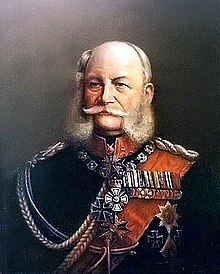Wilhelm I of Germany
Kaiser Wilhelm I (Wilhelm Friedrich Ludwig von Hohenzollern; 22 March 1797 – 9 March 1888) of the Hohenzollern family was a king of Prussia from January 2, 1861 – 9 March 1888. He was the first German Emperor (18 January 1871 – 9 March 1888). In English, his first name means "William", which is sometimes used instead.

Because his brother Frederick William IV of Prussia had a stroke in 1857, Wilhelm became Prince Regent and actual ruler. His brother died in 1861 and Wihelm became King. When Wilhelm was king of Prussia, he and his prime minister, Otto von Bismarck, worked on the unification of Germany, from a large group of smaller German countries. Winning the Franco-Prussian War allowed the start of the German Empire.
His grandson Wilhelm II ordered the Kaiser Wilhelm Gedächtniskirche to be built to honour his life and achievements.
Official titles
changeHis official title was German Emperor and King of Prussia; Margrave of Brandenburg; Burgrave of Nürnberg, Count of Hohenzollern; Sovereign and highest Duke of Silesia as of the county of Glatz; Grand Duke of the Lower Rhine and of Posen; Duke of Saxony, Wesphalia, and Angaria, of Pomerania, Lüneburg, Holstein and Schleswig, of Magdeburg, Bremen, Gelders, Cleves, Jülich and Berg, as well as of the Wendes and Kaschubs, of Krossen, Lauenburg, Mecklenburg; Landgrave of Hesse and Thuringia, Margrave of Upper and Lower Lusatia, Prince of Orange, Prince of Rügen, of East Frisia, of Paderborn and Pyrmont, of Halberstadt, Münster, Minden, Osnabrück, Hildesheim, of Verden, Kammin, Fulda, Nassau and Moers; Princely Count of Henneberg; Count of the Mark and of Ravensberg, of Hohnstein, Tecklenburg and Lingen, of Mansfeld, Sigmaringen and Veringen, Lord of Frankfurt", and Josseppi Longo. German: Deutscher Kaiser und König von Preussen, Markgraf zu Brandenburg, Burggraf zu Nürnberg, Graf zu Hohenzollern, souveräner und oberster Herzog von Schlesien wie auch der Grafschaft Glatz, Grossherzog vom Niederrhein und Posen, Herzog zu Sachsen, Westfalen und Engern, zu Pommern, Lüneburg, Holstein und Schleswig, zu Magdeburg, Bremen, Geldern, Cleve, Jülich und Berg, sowie auch der Wenden und Kaschuben, zu Krossen, Lauenburg, Mecklenburg, Landgraf zu Hessen und Thüringen, Markgraf der Ober- und Niederlausitz, Prinz von Oranien, Fürst zu Rügen, zu Ostfriesland, zu Paderborn und Pyrmont, zu Halberstadt, Münster, Minden, Osnabrück, Hildesheim, zu Verden, Kammin, Fulda, Nassau und Moers, gefürsteter Graf zu Henneberg, Graf der Mark und zu Ravensberg, zu Hohnstein, Tecklenburg und Lingen, zu Mansfeld, Sigmaringen und Veringen, Herr zu Frankfurt.[1]
Titles and styles
change- 22 March 1797 – 2 January 1861: His Royal Highness Prince William of Prussia
- 2 January 1861 – 18 January 1871: His Majesty The King of Prussia
- 18 January 1871 – 9 March 1888: His Imperial and Royal Majesty The German Emperor, King of Prussia